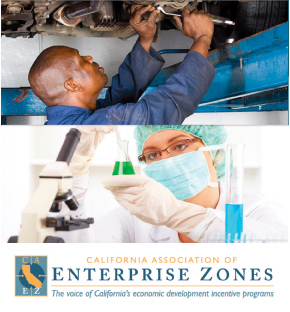|
.jpg)
Despite a longer-than-expected economic recession, California’s successful Enterprise Zone Tax Credit program continues creating jobs in the Los Angeles region and around the state.
The Enterprise Zone program was created in 1984 to stimulate job growth and business investment in some of California’s most economically distressed regions. The 42 zones help create and keep employment opportunities for more than 100,000 residents each year.
Here, in the Los Angeles area, Enterprise Zones continue to bring businesses into our region and improve our higher-than-average unemployment rate.
“The Enterprise Zone program has helped to create and sustain job growth in the City of Los Angeles and throughout the region. Businesses grow here because of the program. They hire local employees, many of whom have been out of work and on government assistance, and have helped bring entire areas out of poverty. These are the types of programs that we need to invest in to get California working again,” said Los Angeles Mayor Antonio Villaraigosa, who has been a strong supporter of the Enterprise Zone program.

The Enterprise Zone program provides tax credits to companies that locate, or relocate, to an economically distressed area. These businesses receive credits for hiring employees with barriers to employment. Employers are encouraged to hire those on public assistance, those with a criminal record and the chronically unemployed.
Unfortunately, in 2011 the governor proposed eliminating this job-creating program.
“While we are all sensitive to the budget troubles in Sacramento, eliminating the Enterprise Zone program will only make the budget situation worse,” said Craig Johnson, president of the California Association of Enterprise Zones. “The program saves the state hundreds of millions of dollars each year by taking people off government-funded services and giving them stable employment. Eliminating the program would have worsened our unemployment problem and increased the business exodus.”
Eliminating the Enterprise Zone program would have forced many businesses to leave the state. Several were courted by neighboring states and made it clear to the governor and Legislature that eliminating the program would be a financial burden they simply couldn’t afford.
This year will prove to be a decisive one for the future of the Enterprise Zone program. While the Legislature refused to bring up the elimination issue last year, the Brown administration and other opponents continue to push for destructive “reforms” that could result in de facto elimination of the program.
For example, the Brown administration is currently delaying the creation of two statutorily required zones. This delay is jeopardizing local businesses’ ability to make hiring decisions that could mean gainful employment for countless individuals.
“The Enterprise Zone program was a powerful incentive we had to relocate to Pasadena. It helps keep down the cost of doing business at a time when our economy is still struggling to recover. It also allows us to stay competitive and makes services more affordable for our clients. It’s not just the people I hire who benefit; it’s the people who rely on our company to provide quality service at an affordable price. The benefits go beyond the business community. Everybody in the state benefits from the Enterprise Zone program. I hope the governor quickly realizes the value of this program and allows businesses like mine to continue using this vital job-creation program,” stated Daniel J. Lien, 1st Vice President and Regional Manager of Inland Community Bank, which is relocating to the Pasadena Enterprise Zone.
California Association of Enterprise Zones president Craig Johnson said that the fight for job creation continues. The Association will continue to work with the governor to ensure that the program remains intact.
To learn more about Enterprise Zones please visit www.caez.org.

|